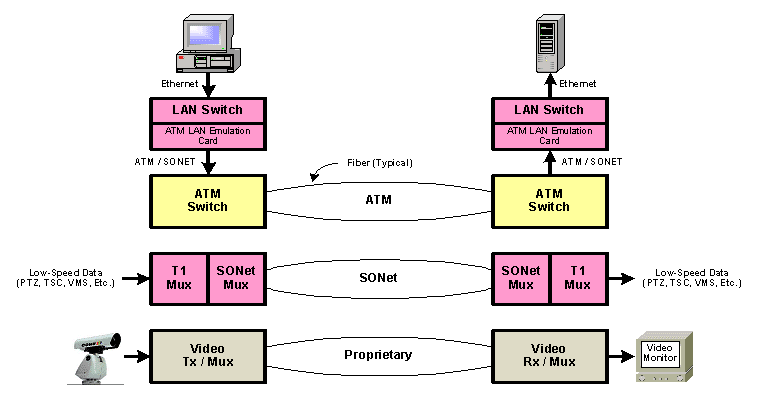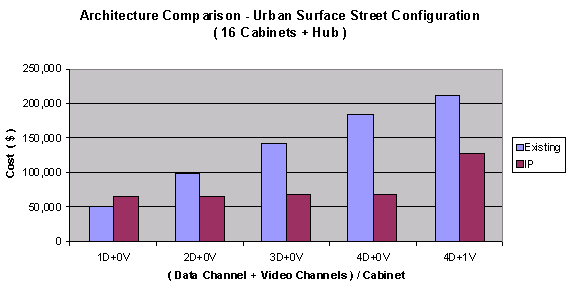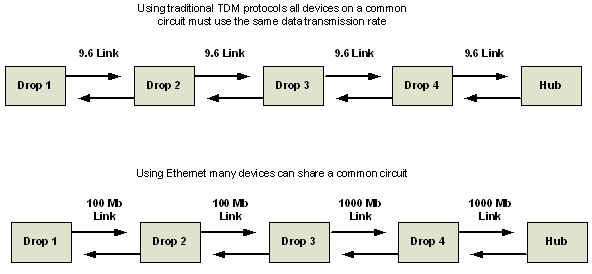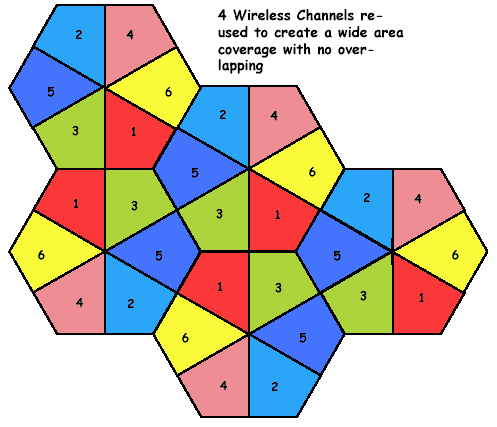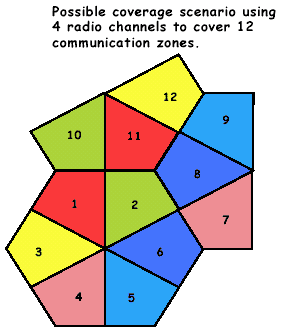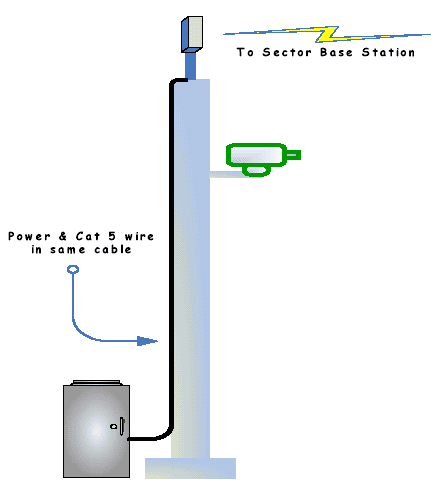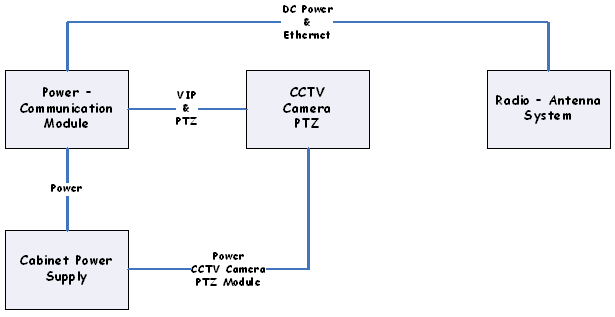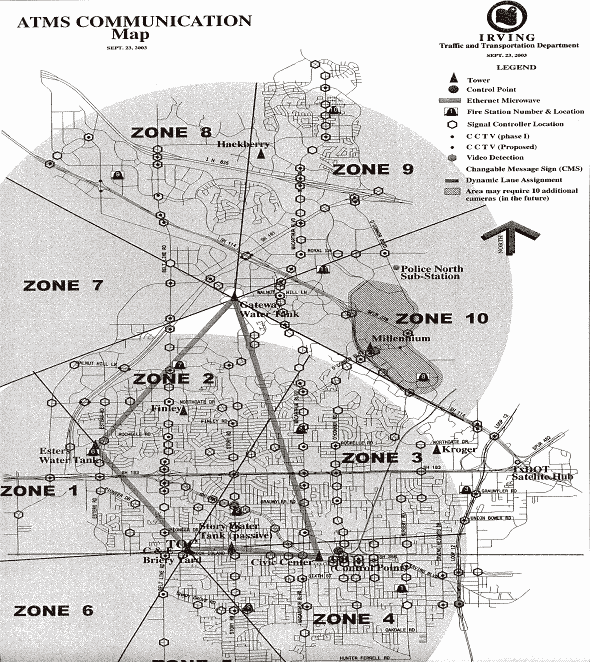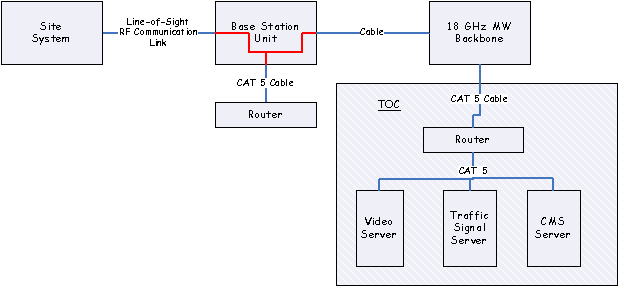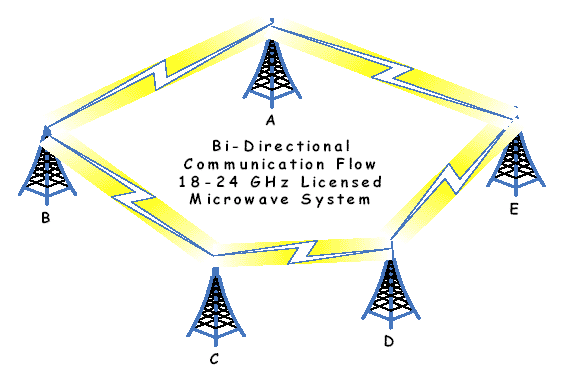Chapter 7. System Examples
Introduction
Departments of Transportation have been learning how to develop telecommunications systems to support traffic and freeway management for many years. There has been a concerted attempt to create a standardized architecture that would support requirements for most deployments. However, one constant that has evolved is that no two systems can be configured in the same way. Many elements (i.e.; modems, video codecs, transmission media, etc.) of a communications system are consistent in their functionality (system to system), but, it is the unique arrangement of those elements that differentiates between systems. Each user has their own set of requirements which a unique (in overall design) telecommunications system is required to support.
This chapter will look at two very different approaches to using telecommunications technologies supporting freeway operations and traffic signal management:
- The Utah Department of Transportation Salt Lake Valley Regional Freeway Management and Traffic Signal System
- The City of Irving Texas Traffic Management System (As this handbook is being written, the system is in the process of being installed).
Both systems, unique in their approach to providing a telecommunications system, have several factors in common:
- Both are upgrades from a legacy system
- Both are the result of requirements to expand overall traffic management services
- Both have a requirement to merge with, and transition from, legacy systems
- Both will use latest generation telecommunications equipment supporting broadband video.
- Both will allow traffic data to be transported to multiple users
- Both will upgrade to take advantage of recently developed IEEE 802 series standards.
- Commonly used telecommunication devices (modems, routers, video CODECs, etc.) have the same functionality in both systems.
The primary differences are that one system was created to support a regional traffic control plan, the other created to cover a small urban/suburban city area. Each system is unique because each was designed to meet a specific set of end-user requirements. The UDOT system was originally designed to support multiple functions incorporating both traffic signal control for local streets, and freeway operations. The City of Irving system was originally designed to support traffic signal management for local streets.
Utah DOT System
Background
In the early 1990's, the Utah Department of Transportation (UDOT) began plans to develop CommuterLink, an Advanced Traffic Management System. This system, started as a regional coordination of signals across jurisdictional boundaries within the Salt Lake Valley, has grown to include over 600 traffic signals, 1400 detector stations, 250 closed circuit television cameras (CCTV), 70 VMS and a wide range of ancillary transportation management systems such as 511, a website, HAR, RWIS, etc. To support this system, UDOT has installed its own dedicated fiber optic communication network.
The communication network encompasses most of the valley, and reaches outwards to include the Cities of Ogden to the North, Spanish Fork to the South, and all other major cities in between such as Provo and Orem. With over 100 miles of fiber optic cable (as of the publication date of this handbook) installed, the system is expected to double by 2006. This network is dedicated exclusively to transportation and security related services and links the UDOT Traffic Operations Center (TOC), the Salt Lake City and County Traffic Control Centers (TCC's), the Utah Transit Authority (UTA) dispatch center, and various emergency management centers.
In response to the new expansion efforts, capacity limitations and some end of life hardware announcements – such as the video matrix switch – UDOT requested that an alternatives analysis, and future needs assessment, be performed to identify new and proven state-of-the-art video technologies and other communication technologies that could be used in an upgraded and expanded CommuterLink. The result of this analysis was a recommendation for full-scale replacement of the existing Javelin video matrix switch, and the conversion from the existing ATM and SONET network to an Ethernet over IP solution.
In the original concept, placement of multiple video matrix switches was envisioned within Regional centers to serve the local areas, with a fixed and limited number of ports being shared between centers (i.e., limiting the transfer between the TOC and Regional Hubs to any 8 video signals at any one time). Implementation of this concept was delayed until after the Olympics because the need was not there, and because new CommuterLink software was also required to control these multiple switches.
Manufacture Discontinue – the manufacturer of a product decides to stop manufacturing a product (or product line), and provide minimal warranty and parts support. |
With the expansion of the number of CCTV cameras and the provisioning of video links to additional agencies, the analysis was expanded to include consideration of the communication requirements necessary to interface with these centers. The use of a video matrix switch with remote nodes is tightly intertwined with a communication infrastructure, and one cannot be analyzed without the other. The resulting analysis took into account all current and envisioned future CommuterLink requirements of the State, County, and municipal agencies within the state of Utah, while preserving to the greatest extent possible, legacy systems. Also considered are recurring and upgrade costs that are associated with a "do nothing" approach. This option is in reality a misnomer, because significant resources are still required to maintain and / or replace obsolescent equipment (i.e., Hub Ethernet switches, fiber modems, etc.).
Note: The above background information was excerpted from an assessment study completed by a consultant for the Utah Department of Transportation. The study makes an important observation about communications technologies and planning – as technology advances, plans must change.
The original plan was to deploy several matrix type video switches in various locations throughout the regional system. Unfortunately, matrix video switches require significant telecommunications infrastructure to support their ability to route video between several locations. Simply put, they are "bandwidth hogs". During the period of the initial deployment of the CommuterLink system communication technology, standards, and processes evolved to provide the ability to route video with significantly less bandwidth and telecommunications infrastructure support. The overriding factors were the continued development of the IEEE 802.3 series of standards, and MPEG video compression standards. Video can now be routed from its source to a desktop computer using "Video-over-IP". The UDOT system takes advantage of these new capabilities. During this same period, the matrix video switcher product line was sold to a new manufacturer. The new company decided to "manufacture discontinue" the product line.
"IP Multicast" – A process that permits distribution of a CCTV camera image to many users. The image is sent to a multicast switch that allows users to view using a Web Browser application on their desktop computer. |
UDOT asked the consultant to look at alternatives to replacing the video matrix switch. The resulting investigation concluded that replacement of the matrix switch with video over IP would provide a significant operational advantage, and provide significant cost savings via the use of lower cost communications infrastructure hardware. The actual recommendation was to migrate to a digital IP communication network with IP Multicast for switching and distribution of the video. However, the existing ATM/SONET telecommunications infrastructure would have to be replaced, or modified. There would be an initial capital outlay to effect this change, but the savings on future equipment purchases (and maintenance) would pay back the initial outlay. Most important, UDOT would gain the ability to route video without having to install and maintain expensive video matrix switchers.
The System – Existing
The current system was evaluated for its ability to support video over IP with the objective of re-using as much of the current telecommunication system as possible. Because the existing system was based on using a video matrix switch there was a single point-of-failure. A matrix switch is nothing more than a large input-output device. In this case, the switch had a capacity of 300 inputs and 200 outputs. The switch would allow any one of the inputs to be output on one, two, three, or more outputs. The mechanics of the switch are such that every one of the inputs and every one of the outputs must be directly connected to an analog video source, or monitor. This was a reasonably efficient design for television production studios of the 1980s and 1990s, and certainly, in the place of any other reasonable alternative, very useable for the CommuterLink system. Lower capacity (and lower cost) switches are used in the security industry.
Video Matrix switches were designed to take an analog video source and route it to a recording unit, or a video monitor within a television production studio, or within a large office building, or between several buildings in a campus environment. To use it in a transportation environment, the video from CCTV cameras must be transported from the field to the Traffic Control Center. This requires using a significant amount of fiber optic strands (or coaxial cables) to support a large number of CCTV cameras for direct camera to switch connections. Another option is to convert the video to a compressed digital signal, multiplex it with other video signals and transport to a TOC where the signal is de-multiplexed, un-compressed, and then connected to the switch. Either of these scenarios creates a situation that is hardware intensive, and costly to deploy and maintain.
Deployment of the CommuterLink systems occurred over a period of years and utilized three generations of communication distribution networks. The distribution networks progressed from a requirement to use one strand of fiber per CCTV camera, plus two strands of fiber for a multi-drop PTZ communication link, plus two strands of fiber for a multi-drop traffic controller/traffic device data link, to a single strand of fiber for all three systems. UDOT uses two primary fiber optic cable networks:
- Backbone – designed to provide service from communication hubs to the TOC
- Distribution – designed to provide service from field cabinets to the communication hubs.
The change in the design of the distribution network systems provided a significant savings in the amount of fiber strands and the amount of communication equipment required in the field cabinets. However, there was no change in the amount of fiber required between the hubs and the TOC.
Between the hubs and the TOC, UDOT used three separate communication networks:
- ATM to provide connectivity between various computer systems
- SONET to provide communication for low speed data channels that served camera PTZ, changeable message signs, traffic signal controllers, and other devices
- Video to provide transport of full motion video from cameras.
The UDOT Network diagram provides a graphical representation of the three communication networks used for the overall system. The first generation system used separate fiber strands for each network in both the distribution and the backbone cables. Subsequent generations used fewer fibers in the distribution cable, but continued to use separate fibers in the backbone cable.
The System – New
UDOT originally considered deploying additional analog video matrix switches to route video to other centers and user agencies. The existing fiber optic cable infrastructure would have to be expanded to support the additional switches. With the knowledge that the video matrix switch product was taken out of production and no longer supported by the manufacturer, UDOT looked at alternative video distribution strategies. This led to a complete review of existing systems and their communication requirements.
The decision was made to complete a phased replacement of the telecommunication system and the analog video matrix switch. This process would be facilitated by the fact the existing fiber optic able infrastructure would not have to be replaced. A recommendation was made to convert the video signal to a digital IP format in the field cabinet.
The comparison shows that significant savings are gained by converting to an IP architecture. Table 7-1 provides a list of estimated costs and a proposed upgrade schedule:
UDOT can continue to use the existing systems and provide upgrades over time to minimize overall budget impact. As shown in the above table, there are no expenses to modify the existing fiber optic cable infrastructure. Affiliated user agencies can be added at minimal cost because the video, and other data, can be routed using standard Ethernet architecture and lower cost off-the-shelf hardware.
A major advantage of using the Ethernet architecture is that it can support multiple devices requiring different data transmission speeds. Multi-drop communication circuits – such as those used with traffic signal controllers – require that all devices communicate at the same data rate. The compressed video signal from a CCTV camera cannot be added to a multi-drop circuit used for traffic signal controllers unless the video signal is transmitted at the same data rate. Most traffic signal controllers use a data rate of 9.6 Kbps and most compressed video signals are transmitted using a data rate of between 384 Kbps and 1 Mbps. Using Ethernet and IP protocols, each device can transmit at its own data rate. Therefore, many different devices can share a common data communication circuit. The end result is a simplification of the overall communication system, i.e., fewer strands of fiber, and less hardware.
The full report: CommuterLink Communication System Analysis – Alternative Architecture Options - is available on the USDOT Joint Program Office web site.
City of Irving, Texas
Background
Irving, Texas, a community of about 200,000 residents, is part of the Dallas-Fort Worth Metro Area, and home to the Dallas Cowboys Football Stadium. The Traffic and Transportation department is responsible for the operation and maintenance of the traffic signal system – a system with 175 signalized intersections. Most operate on a "time-of-day" signal plan, and a few are closed-loop. The current system uses several versions of the NEMA traffic signal controller, and there is no centralized control. The department relies on telephone callers to report problems and dispatches technicians to investigate and effect repairs. The City of Irving is seeking to update its current traffic signal system to provide for centralized control and problem location. The traffic department is proposing to replace the variety of signal controllers with the 2070 type.
The update calls for the total replacement (over time) of the NEMA type controllers, addition of CCTV cameras, traveler information signs, and centralized control of all traffic signals. Central control would provide immediate notification of signal problems and allow for dynamic re-timing of signals to account for special events or significant traffic incidents. The use of CCTV cameras would provide real-time viewing of congestion problems and support temporary re-timing plans.
Proposed Update
An overall development plan with the objectives of standardizing on one controller type, one software system, one cabinet type, and centralized signal control was created. The department recognized the need to provide a telecommunications infrastructure to support the plan, and the construction of a private fiber optic communications network was considered. TEA21 funding was requested, and granted. However, the level of funding was substantially less than needed. The ultimate objective of adding all signals to the communication network could not be realized if a fiber network was used. The estimated cost of the fiber optic network was $10 million.
The City looked for alternate communication technologies to support their plan. Their first consideration was the use of leased telecommunication services from local carriers. This plan was rejected because:
- The overall cost exceeded funding levels
- Available bandwidth was insufficient to handle the individual (3 MB) video feeds required for the system
- The city did not want to incur a monthly recurring expense
The City investigated wireless systems and discovered that they could provide total coverage at a substantially reduced cost over the fiber optic and leased telecommunication networks. Requirements for the system included:
- Broadband capability to support video
- Point-to-multipoint to support centralized control
- Ability to add locations with minimal system disruption (scaleable)
- Ability to add locations with easy to configure communications hardware
- Communication system reliability
- Overall initial system costs kept within budgeted levels
In addition to the centralized control of traffic signals, the Irving Traffic Department wanted to provide:
- CCTV cameras with pan-tilt-zoom
- Changeable message signs
- Dynamic lane assignment
- Video incident detection
- Additional advanced traffic management features
- Real-time traveler information
The city has made a significant investment in a wireless infrastructure to support operational agencies and services. They currently use 5.8 GHz microwave (Wi-Fi 802.11a), 24/23 GHz microwave, and 18 GHz microwave. A group of experienced, licensed radio technicians are on staff to maintain and operate the radio networks.
Considering several different wireless network topologies, the city sought a design that would provide the necessary bandwidth, secure transmission and high availability (99.999%). The typical point-to-point-to-point (multi-drop) design used for most traffic signal wireless communication systems did not prove to be adequate for a system that would ultimately be required to support more than 70 CCTV cameras, and almost 200 signalized intersections.
The city's Communication & Electronics Department investigated a wireless system designed to provide broadband internet access. They found a product that is compliant with the IEEE 802.16 and 802.16a standard. The 802.16a standard provides for a significant reduction in the potential for interference from other radio systems on the same or adjacent channels. The IEEE 802.16 was developed as the "Air Interface for Fixed Broadband Wireless Systems." This standard describes wide area wireless networks (WAN) and is designed to provide coverage in terms of miles. Compare this with the IEEE 802.11 wireless standard series developed for local area wireless network (LAN) coverage, with coverage distances measured in terms of feet.
5.8 GHz Attributes
- Operates in 5.8 GHz U-NII/ISM frequency spectrum
- Scaleable throughput from 20 Mbps to 60 Mbps
- Base station can provide up to 360 degree coverage in 60 degree segments
- Simplified installation using a self-enclosed radio/antenna module with Ethernet 10/100 baseT connections.
- Compliance with IEEE standards: 802.1d; 802.1q; 802.16; 802.16a.
- Additional field units can be installed without disrupting current operations.
Theory of Operation
The FCC has designated four operational communication channels within the 5725 to 5825 MHz frequency range. Each channel occupies 25% of the available spectrum. Each of the four channels can be used to cover a 60 degree arc. Re-using two of the four channels permits a six channel array for coverage of a 360 degree circle. Following are examples of how the four wireless channels can be re-used to provide total coverage without over-lap.
Each of the individual coverage hexagons has an array of six base stations at the center and referred to as a "Hub Site". The base stations are networked to provide for a 360 degree coverage area. Field units, also called "Subscriber Units", have a highly directional antenna pointed toward the sector base station providing the best line-of-sight coverage. It is also possible to create communication path redundancy for a subscriber site.
The Irving Proposal
The initial plan calls for the development in two phases of six (6) coverage zones each. The first phase will use a single base site with six coverage zones. The second phase will use two base station sites with three coverage zones each. Future system upgrades will permit additional zones to be added as required.
Some of the coverage zones may overlap, but the subscriber units are set to a specific radio channel to prevent interference from other base stations. Also, the subscriber unit antennas are highly directional and aimed at a single base station.
Notice that a single cable runs from the antenna/radio system to the cabinet. Inside the cabinet is a communication module that provides power and Ethernet to the radio unit at the top of the pole. The VIP signal, and PTZ signal, from the camera are connected via the communication module to the CAT 5 pairs in the cable. The CCTV camera has a built-in (12) CODEC-VIP module that converts the video to IP.
Following (Figure 7-8) is a site schematic diagram:
Individual site antennas are oriented toward a specific base station unit. The highly directional system prevents overlap and allows for optimization of communications traffic through any single system. Irving TTD has assigned each signal device a communication zone within the coverage grid. They have also proposed locations for CCTV cameras and other equipment. The following map shows the overlay of the coverage zones and where each device and signal controller is located:
The overall objective of the Irving Traffic & Transportation department is to update the current system, standardize on the types of devices being deployed, and provide for greater efficiencies in the overall management of their system. The use of a technology initially developed to provide broadband internet service is a reasonable choice given the total cost of implementation and operation. Fixed broadband wireless communications systems are also being applied for security, water and wastewater management, and agricultural operations systems.
Tie-in to Main Communication Network
The City has a microwave communication backbone that connects all major systems. The backbone system is a point-to-point microwave communication link. Five sites are set up in a loop configuration to allow for a self-healing ring and redundant paths to all sites. The paths are rated at 100 Mbps to carry maximum bandwidth in either direction of the loop and operate in the 18 to 23GHz licensed microwave range. 100 Mbps is currently the maximum available, but several manufacturers are in the process of testing with 240 Mbps systems. The schematic shows how the Traffic system ties into the microwave communications backbone.
The broadband base stations are connected to a microwave radio backbone for transmission to the Traffic Operations Center.
Conclusion
This chapter has provided two very different solutions for a similar problem – updating an existing system with the incorporation of legacy devices and newer technology. Both user agencies evaluated their needs and options. Utah has an existing fiber optic communications network that it wanted to update. Irving, Texas has an existing traffic signal system that needed modernization. The same general requirement resulted in two very different approaches to the use of communication systems. The examples used point to the fact that there are many different telecommunication system designs that can be used to solve similar problems. Each design (solution) is unique to the needs of the end users. The lesson learned is to consider all possibilities and select the one that meets your needs.
